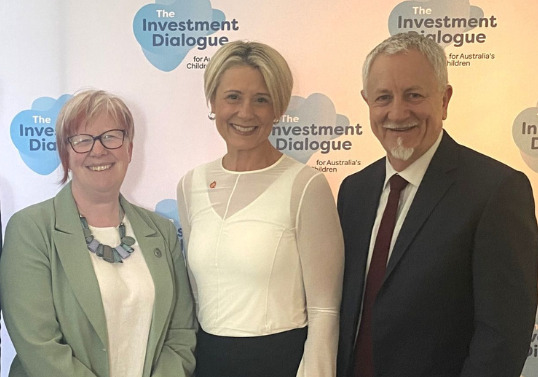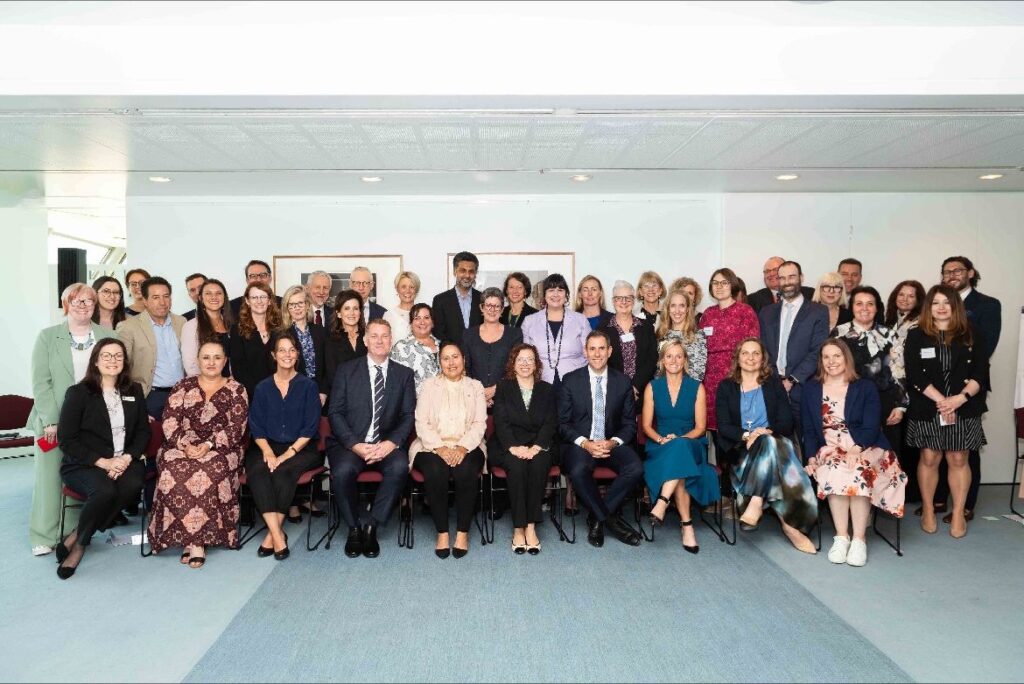Investment Dialogue for Australia’s Children gets under way at Canberra roundtable

Philanthropy and government have come together in what could be the largest ever structured collaboration between the sectors in the country’s history. Formalised this week in Canberra, the Investment Dialogue’s collective aim is to improve the wellbeing of children, young people and their families by working with communities to reduce intergenerational disadvantage in Australia. The initiative is shaping up as an unprecedented, long-term, integrated and community-led approach to supporting children, families and communities to thrive.
Treasurer Jim Chalmers, Social Services Minister Amanda Rishworth and Indigenous Affairs Minister Linda Burney joined the philanthropic partners for the inaugural roundtable of the Investment Dialogue for Australia’s Children in Canberra on Monday, which was chaired by CEO of the Paul Ramsay Foundation, Professor Kristy Muir.
Outcomes of the roundtable include the signing of a Working Together Agreement by the ministers and the philanthropic groups leading the collaboration, including Professor Muir, Paul Conroy from The Ian Potter Foundation and Matthew Cox from The Bryan Foundation. Core elements in the agreement include commitments on collaboration; a long-term approach to deliver intergenerational change for young people facing disproportionate levels of disadvantage, including Aboriginal and Torres Strait Islander peoples, people with disability, and those from diverse cultures; community-led initiatives; meaningful outcomes and evidence-based continual improvement.
Professor Muir said: “We’re thrilled to see this important collaboration between government and philanthropy take the first steps in building a new, more integrated approach that better supports children, young people and their communities.
“This is a unique opportunity to make a real difference with innovation across sectors, in partnership with communities, to empower children and their families through a collaborative effort.”
The philanthropic members announced $65 million in commitments towards projects and initiatives aligned to the Investment Dialogue’s vision, which have been initiated by philanthropy since conversations about the collaboration commenced in September 2022. This funding will support improved outcomes for children and families, including programs for early childhood development, First Nations-led education and youth employment initiatives. It will also help enable community-led change through investments in workforce capacity-building and integrated data solutions. The Investment Dialogue is also part of the $199.8 million package from Government announced in the last Federal budget to target entrenched disadvantage, which has a strong focus on place-based, community-led change. It will support greater collaboration and coordination of government and philanthropic investments to improve outcomes for communities.
Participants also agreed to embed community voices at the heart of the Dialogue’s work and agreed to establish a Community Leadership Council and a First Nations Leadership Council. These councils will ensure the Dialogue reflects the priorities of local communities and build on community-led efforts already under way across Australia. Catherine Liddle, CEO of SNAICC (the national Aboriginal community-controlled organisation for Aboriginal and Torres Strait Islander children) will chair the Community Leadership Council and April Lawrie, the South Australian Commissioner for Aboriginal Children and Young People, will chair the First Nations Leadership Council.
Jack Heath, Philanthropy Australia CEO who attended the roundtable, said: “The thought, commitment and goodwill in the room at the inaugural roundtable in Canberra was deeply encouraging and a great start.
“In philanthropy, we’ve seen time and again that backing communities to develop and lead on solutions to the issues communities face gets the best results.
The National Roundtable will meet twice a year and is supported by the Investment Dialogue Implementation Group, which consists of senior executive representatives from government agencies and lead philanthropic members, along with ARACY – Australian Research Alliance for Children and Youth as the Strategic Convenor.
“The Investment Dialogue is an innovative three-way model between community, government and philanthropy that has been developed with deep consideration in how best to bring about a generational shift in educational and wellbeing outcomes for children and young people and the communities in which they live. Philanthropy Australia applauds the great leadership from all sides behind this initiative.”

Outgoing ARACY CEO Penny Dakin said: “We’re really delighted to have the Investment Dialogue for Australia’s Children formally up and running. On the day, we were privileged to have April Lawrie and the Hon Linda Burney attend and share their stories from children and communities with the room. The combination of collaboration and respect for community voice was palpable. There was a great shared spirit of commitment in the room.”
Social Services Minister Amanda Rishworth said: “Disadvantage is a complex problem which no single policy, government department, organisation or entity can solve. But in order to make a tangible difference across generations, partnerships are key.”
Treasurer Chalmers said: “Action in the early years of a child’s life – including through health, education and protection from harm – is key to breaking cycles of disadvantage.
“This is about empowering local leaders by ensuring that Government and philanthropy work together to maximise our efforts – and ultimately delivering the best value for disadvantaged communities and children.”